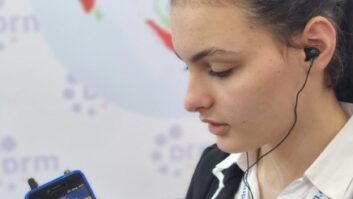
The DRM system design concept splits the transmission chain in three major steps: the content encoding and multiplex generation step (ContentServer), the modulation process including equalization and signal conditioning (exciter) and last but not least the power amplification and signal emission (transmitter and antenna).
Whereas the DRM system design expects the content encoding and multiplex generation to happen in the studio the current experience is that most of the DRM installations are using a transmission site encoder/multiplex generator build into the DRM exciter — at least as a starting point, as backup and/or for system testing.
These built-in encoders/multiplexers are typically very limited in functionality and flexibility. With the new Transradio DMOD3-CS, the company has provided the next step in functionality integration.
The DMOD3-CS combines an advanced and highly successful DRM exciter, DMOD3, with a high-quality DRM audio/multimedia encoder and multiplex generator based on Fraunhofer’s DRM ContentServer R5 technology. This technology includes the superior new xHE-AAC audio codec which was just integrated into the DRM standard in January.
The DMOD3-CS is perfectly adjustable to the individual needs of each customer while the functionality can easily be upgraded at any time to keep up with growing requirements.
As an exciter the DMOD3-CS offers all of the features of the DMOD3 such as automatic initial equalizer adjustment for easy installation, automatic measurement point selection and dynamic pre-correction during DRM operation for a high-quality on-air signal and the very short mode change times to minimize interruptions — all combined with highest reliability and robustness. The DMOD3 also has proven its effortless compatibility with all major transmitter brands and thus is deployed today in a large number of DRM installations around the world.
The integration of Fraunhofer’s DRM ContentServer R5 technology now greatly enhances the functionality of Transradio’s DMOD3 at the encoder and multiplex generation side. Most of the many features of a standalone FhG ContentServer can now be offered by the DMOD3-CS:
● Encodes the standardized maximum number of four DRM services in parallel, with access to all multiplex configuration and signaling options provided by the DRM standard
● Supports all audio codecs defined by the DRM standard including the superior all-bitrate xHE-AAC codec
● Provides management/configuration options for every standardized DRM data service such as Text Messages, Journaline, Slideshow, EPG/Electronic Program Guide, TPEG/TMC traffic information, along with flexible interfaces for future and broadcaster-specific applications
● Easy configuration planning based on weekly calendars and interfaces for external reconfiguration triggers
This unique combination of content encoding and exciter features turns the now available DMOD3-CS into a complete DRM solution.
Christian Hörlle is project manager Digital Radio at Transradio.












